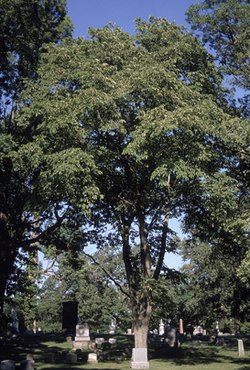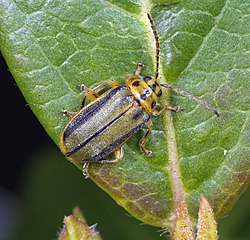Elm
Elms are deciduous and semi-deciduous trees,[1] found throughout the Northern Hemisphere from Siberia to Indonesia, Mexico to Japan. They have alternate, simple, single- or doubly-serrate leaves, usually asymmetric at the base and sharply pointed at the tip.
| Elm | |
|---|---|

| |
| Mature Slippery Elm | |
| Scientific classification | |
| Kingdom: | |
| Division: | |
| Class: | |
| Order: | |
| Family: | |
| Genus: | Ulmus |
| Species | |
Elms are hermaphroditic, having perfect flowers, and which, being wind-pollinated, are without petals. The fruit is a round samara.
Elms take many decades to grow to maturity.
Elm Media
Golden elm tree with Dutch elm disease
The elm leaf beetle
The ball-headed graft narvan elm, Ulmus minor 'Umbraculifera', cultivated in Persia and widely planted in central Asia
Lafayette Street in Salem, Massachusetts - an example of the high-tunneled effects of Ulmus americana avenues once common in New England (colorized postcard, 1910)
Camperdown elm (Ulmus glabra 'Camperdownii'), cultivated in Prospect Park, Brooklyn, New York
An avenue of elm trees in Fitzroy Gardens, Melbourne
A row of Princeton elm trees, which are moderately resistant to Dutch elm disease, at Scripps College in Claremont, California.
American elm trees along the Mall and Literary Walk in New York City's Central Park (2013)
Rows of American elm trees line a path south of the Lincoln Memorial Reflecting Pool on the National Mall in Washington, DC (November 11, 2006)
References
| Wikimedia Commons has media related to Lua error in Module:Commons_link at line 62: attempt to index field 'wikibase' (a nil value).. |
- Collin, E. (2001). Elm. In Teissier du Cros (Ed.) (2001) Forest Genetic Resources Management and Conservation. France as a case study. Ministry of Agriculture and Fisheries, Bureau of Genetic Resources. INRA DIC. France.
- Cornell University: Elm hybrids (pdf file)
- Martín-Benito D., Concepción García-Vallejo M., Alberto Pajares J., López D. 2005. Triterpenes in elms in Spain. Can. J. For. Res. 35: 199–205 (2005). [1] Archived 2007-06-28 at the Wayback Machine
- Mittempergher, L. & Santini, A. (2004) The history of elm breeding. Investigacion agraria: Sistemas y recursos forestales 13(1): 161-177 (2004).
- Ware, G. (1995). Little-known elms from China: landscape tree possibilities. Journal of Arboriculture, (Nov. 1995). International Society of Arboriculture, Champaign, Illinois, USA. [2] Archived 2007-11-30 at the Wayback Machine.









